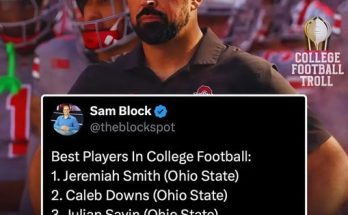The Texas Longhorns are not just recruiting—they’re building an empire. With a flurry of top-tier commitments and relentless momentum on the trail, Steve Sarkisian and his staff are making a legitimate push to secure the No. 1 recruiting class in the nation for 2026. Texas has long been a powerhouse on the trail, but the current trajectory suggests something unprecedented is taking shape in Austin. The blend of in-state dominance, out-of-state raids, and position-by-position excellence is propelling the Longhorns to the pinnacle of college football recruiting at a moment when perception and performance are colliding perfectly.
When Sarkisian first arrived in Austin, he made it clear that the goal was to recruit with the best in the country—and to do it with a strategic vision rooted in Texas pride. Fast-forward to 2025, and that vision is being executed with surgical precision. The Longhorns have managed to lock down the Lone Star State’s finest while also pulling elite prospects from across the nation. That delicate balance is a trademark of recruiting powerhouses like Georgia and Alabama, but now Texas is flexing that same national muscle. The 2026 class is shaping up to be a defining one—not just in talent, but in the message it sends: Texas is back, and it’s built to stay.
What makes this recruiting push even more remarkable is its breadth. It’s not just about skill positions or headline-making quarterbacks. The Longhorns are loading up across the board. Defensive linemen, offensive tackles, lockdown corners, dynamic running backs, and playmaking wideouts—all are flocking to Texas, signaling a belief in the program’s direction. The crown jewel thus far is Derrek Cooper, the No. 1 running back in the country, who stunned the SEC landscape by choosing Texas over Georgia. Cooper’s commitment wasn’t just a recruiting victory—it was a statement. Texas can now go toe-to-toe with the sport’s most dominant programs and come out on top.
Cooper’s decision to commit to Texas also underscores something deeper: the relationships Sarkisian and his staff have been cultivating are paying off in major ways. It’s not just about the facilities or NIL opportunities. It’s about trust, vision, and alignment. Cooper spoke about the authenticity he felt in Austin, the plan laid out for him, and the way the coaching staff not only embraced him but made him feel like a foundational piece of a championship puzzle. That’s the kind of resonance that doesn’t happen overnight. It’s the result of years of groundwork and culture-building—something Texas has quietly been doing while the rest of the country was watching the likes of Alabama, Ohio State, and Michigan dominate the headlines.
Another critical element of this rise is the level of talent that continues to stack on top of itself. Recruiting success begets more recruiting success. Blue-chip prospects want to play with other elite talents, and Texas is creating a gravity around its program that’s impossible to ignore. Top players across multiple positions are now considering the Longhorns as not just a contender, but a destination. That shift in perception is seismic. It’s why Texas is starting to land commitments from players who, in previous years, might have defaulted to programs with more recent success on the national stage. But with a College Football Playoff appearance under their belt and the SEC transition on the horizon, Texas suddenly looks like both a current and future powerhouse.
Part of this climb also involves a level of recruiting agility that few programs can match. Texas isn’t just winning battles for players in Dallas, Houston, and San Antonio. They’re going into Georgia, Florida, California, and the Midwest and pulling prospects who would traditionally stay closer to home. That national footprint is a hallmark of programs that aim to be perennial national title contenders. It’s not enough to dominate your region—you have to out-recruit the best everywhere. And right now, Texas is doing just that. They’re not just knocking on the door of No. 1—they’re kicking it down.
Equally important is the development infrastructure that Texas is selling to these recruits. It’s not just about the stars or social media graphics. It’s about putting players in the best position to succeed at the next level. Sarkisian’s NFL experience, the revamped strength and conditioning program, and the pipeline that’s been established to Sunday football are all resonating with recruits and their families. Texas is making the case that it’s a place where elite players can grow into elite pros. And with the NFL Draft success of late, that case is only getting stronger.
The timing of this surge couldn’t be better. As the Longhorns prepare to enter the SEC full-time, the margin for error shrinks dramatically. Depth, development, and top-end talent become non-negotiables. The 2026 class isn’t just about competing—it’s about winning. And Texas is stockpiling the kind of roster that can go toe-to-toe with the Alabamas and LSUs of the world. This class is about establishing a new baseline for what Texas football should look like in the modern era: fast, physical, versatile, and deep. The SEC is a gauntlet, but Texas is loading up to not just survive it, but to thrive.
The buzz surrounding the 2026 class is also having a ripple effect on the current roster. When elite recruits choose your program, it sends a message to everyone else: this is a place where big things are happening. That energy carries into practice, into the locker room, and onto the field. It creates a culture of competition and excellence that feeds itself. The veterans feel it. The young guys feel it. The future commits see it. It becomes part of the program’s DNA. That’s the kind of momentum Texas is riding right now, and it’s why so many experts believe they’ll finish with the No. 1 class in the country.
Recruiting rankings, of course, aren’t everything. Championships aren’t won in February or July. But they are heavily influenced by the kind of talent you can bring in consistently. And for Texas, this class represents more than just names on paper—it’s a culmination of years of vision, strategy, and execution. It’s the kind of class that can shift a program’s trajectory for the next decade. And for Sarkisian, it’s a validation of the blueprint he brought to Austin when many were still skeptical.
As the commitments continue to roll in, the Longhorns find themselves in rarified air. Programs like Alabama, Georgia, and Ohio State have long held the No. 1 recruiting class as a symbol of dominance. Now Texas is threatening to claim that throne—and they’re doing it with a mix of flash, substance, and momentum that’s hard to match. The job isn’t done yet, but the signs all point in one direction: up.
If Texas finishes with the top class, it won’t be a surprise. It’ll be the logical outcome of a recruiting operation firing on all cylinders, a coaching staff connecting on a human level, and a program that’s once again living up to its immense potential. From the recruiting trail to the weight room to the war room, the Longhorns are sending a clear message to the rest of college football: they’re not chasing greatness anymore—they’re building it. And the 2026 class might just be the foundation of a new golden era in Austin.



